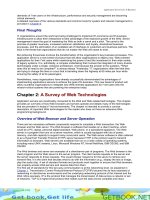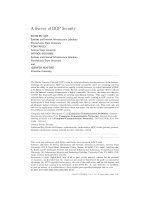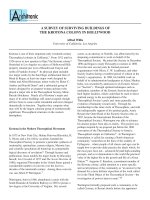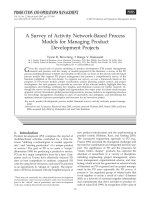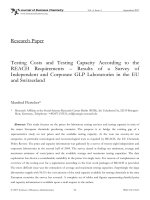A survey of mobile phone sensing
Bạn đang xem bản rút gọn của tài liệu. Xem và tải ngay bản đầy đủ của tài liệu tại đây (631.61 KB, 27 trang )
Slides prepared by Ben Pitts
1
A Survey of
Mobile Phone Sensing
/>
Nicholas D. Lane
Emiliano Miluzzo
Hong Lu
Daniel Peebles
Tanzeem Choudhury - Assistant Professor
Andrew T. Campbell - Professor
Mobile Sensing Group, Dartmouth College
September 2010
2
Mobile Phone Sensors
Devices use sensors to drive user experience:
iPhone 4
Phone usage:
Light sensor – Screen dimming
Proximity – Phone usage
Content capture:
Camera – Image/video capture
Microphone – Audio capture
Location, mapping:
GPS – Global location
Compass – Global orientation
Device orientation:
Accelerometer & Gyroscope – Local orientation
3
Classifying Activities
Sensors can also collect data about users and their surroundings.
Accelerometer data can be used to classify a user’s movement:
Running
Walking
Stationary
Combining motion classification with GPS tracking can recognize the user’s mode of
transportation:
Subway, bike, bus, car, walk…
4
Classifying Activities
Phone cameras can be used to track eye movements across the device for accessibility
Microphone can classify surrounding sound to a particular context:
•
•
•
•
Using an ATM
Having a conversation
Driving
Being in a particular coffee shop
5
Custom Sensors
Device sensors are becoming common, but lack special capabilities desired by
researchers:
Blood pressure, heart rate, EEG
Barometer, temperature, humidity
Air quality, pollution, Carbon Monoxide
Specialized sensors can be embedded into peripherals:
Earphones
Dockable accessories / cases
Prototype devices with embedded sensors
6
Research Applications - Transportation
Fine grained traffic information collected through GPS enabled phones
MIT VTrack (2009)
25 GPS/WiFi equipped cars, 800 hours
Mobile Millenium Project (2008)
GPS Mobile app: 5000 users, 1 year
Google Maps keeps GPS history of all users
Real time traffic estimates
Route analysis (19 minutes to home)
Navigation / route planning
7
Research Applications – Social Network
Users regularly share events in their lives on social networks. Smart devices can
classify events automatically.
Dartmouth’s CenceMe project (2008)
•
•
•
Audio classifier recognizes when people are talking.
Motion classification to determine standing, sitting, walking, running.
Server side senses conversations, combines classifications.
8
Research Applications
Environmental Monitoring
UCLA’s PEIR project (2008)
App uploads GPS signal and motion classification.
Server combines data sources:
GPS traces
GIS maps
Weather data
Traffic data
Vehicle emission modeling
•
•
•
•
•
Presents a Personal Environmental Impact Report
CO and PM2.5 emission impact analysis
PM2.5 exposure analysis
•
•
9
Research Applications – Health
Sensors can be used to track health and wellness.
UbiFit Garden (2007, 3 months)
App paired with wearable motion sensor
Physical activity continuously logged
Results represented on phone’s background as a garden
This “Glanceable display” improved user participation dramatically
•
•
•
•
10
Research Applications – App Stores
3rd party distribution for each platform
•
•
•
•
•
Google Play (formerly Android Market)
Apple App Store
Nokia Ovi
Blackberry World (formerly Blackberry App World)
Windows Phone Store (formerly Windows Phone Marketplace, soon to be Windows Store)
App store popularity allows researchers to access large user bases, but brings
questions:
Assessing accuracy of remote data
Validation of experiments
Selection of study group
Massive data overload at scale
User privacy issues
•
•
•
•
•
11
Sensing Scale and Paradigms
Sensing Scale
Personal sensing
Group sensing
Community sensing
•
•
•
Sensing Paradigms
Participatory sensing
•
•
▫
▫
User takes out phone to take a reading
Users engaged in activity, requires ease of use and incentive
▫
▫
▫
Minimal user interaction
Background data collection
Constantly uses device resources
Opportunistic sensing
12
Sensing Scale – Personal Sensing
Personal Sensing
Tracking exercise routines
Automated diary collection
Health & wellness apps
•
•
•
Sensing is for sole benefit of the user.
High user commitment
Direct feedback of results
•
•
13
Sensing Scale – Group Sensing
Group Sensing
Sensing tied to a specific group
Users share common interest
Results shared with the group
Limited access
•
•
•
•
Example: UCLA’s GarbageWatch (2010)
Users uploaded photos of recycling bins to improve recycling program on campus
•
14
Sensing Scale – Community Sensing
Community Sensing
Larger scale sensing
Open participation
Users are anonymous
Privacy must be protected
•
•
•
•
Examples:
Tracking bird migrations, disease spread, congestion patterns
Making a noise map of a city from user contributed sound sensor readings
•
•
15
Sensing Paradigms
User involvement has its own scale:
Manual (participatory) collection
Better, fewer data points
User is in the loop on the sensing activity, taking a picture or logging a reading
Users must have incentive to continue
•
•
•
Automatic (opportunistic) collection
Lots of data points, but much noisy/bad data
Users not burdened by process, more likely to use the application
Application may only be active when in foreground
•
•
•
16
Mobile Phone Sensing Architecture
Sensing applications share common general
structure:
Sense – Raw sensor data collected from
device by app
Learn – Data filtering and machine
learning used
Inform – Deliver feedback to users,
aggregate results
•
•
•
17
Sensing – Mobile Phone as a Sensor
Programmability
•
•
•
•
•
•
Mobile devices only recently support 3rd party apps (2008+)
Mixed API and OS support to access sensor data
GPS sensor treated as black box
Sensors vary in features across devices (see 5S)
Unpredictable raw sensor reporting
Delivering raw data to cloud poses privacy risks
18
Sensing – Continuous Sensing
Sampling sensors continuously
Phone must support background activities
Device resources constantly used
•
•
▫
▫
▫
▫
▫
CPU used to process data
High power sensors (GPS) polled
Radios frequently used to transmit data
Expensive user data bandwidth used
Degrading user’s phone performance will earn your app an uninstall
▫
▫
Balance data quality with resource usage
Energy efficient algorithms
Continuous sensing is potentially revolutionary, but must be done with care
19
Sensing – Phone Context
Mobile phones experience full gamut of unpredictable activity.
Phone may be in a pocket, in a car, no signal, low battery.. Sensing application must
handle any scenario.
Phone and its user are both constantly multitasking, changing the context of sensor
data
Some advances:
Using multiple devices in local sensing networks
Context inference (running, driving, in laundry)
•
•
•
•
20
Learning – Interpreting Sensor Data
Interpreting potentially flakey mobile data requires context modeling. Data may only
valid during certain contexts (running, outdoors…)
Supervised learning: Data is annotated manually, these classifications improve
machine learning.
Semi/unsupervised learning: Data is wild and unpredictable, algorithms must infer
classifications.
Accelerometer is cheap to poll and helpful to classify general activity (moving/still)
Microphone can classify audio environments at cost of CPU resources and algorithm
complexity
Involving the user in automatic classification can be helpful, but adds interaction
complexity
•
•
•
•
•
21
Learning – Scaling Models
Many statistical analysis models are too rigid for use in mobile devices. Models must be
designed flexible enough to be effective for N users.
Adaptive models can query users for classification if needed.
A user’s social network can help classify data, such as significant locations.
Hand annotated labels may be treated as soft hints for a more flexible learning
algorithm.
Complex adaptive algorithms bring increased resource usage.
•
•
•
•
22
Inform, Share, Persuade
Once data is analyzed, how are results shared with users?
How to close the loop with users and keep them engaged
•
Sharing - Connecting with web portals to view and compare data
•
Personalized Sensing – Targeting advertising to your habits
•
Persuasion – Showing progress towards a common goal, encouraging users
•
Privacy – Treating user data mindfully
23
Share
The sensing application must share its findings with the user to keep them engaged and informed.
Can be tied with web applications (Nike+)
Form a community around the data
Allow users to compare and share their data
Nike+ collects a simple data set (run time and distance) but users are actively engaging in the web
portal
•
•
•
•
24
Personalized Sensing
A user’s phone can constantly monitor and classify their daily life; the data collected is highly
personal.
Targeted advertising would love to know just when to show you a certain ad
Your phone can provide personalized recommendations targeted to your location and activity
A common sensing platform could feed classifications and data to other apps and services
•
•
•
25
Persuasion
Sensing applications usually involve a common goal, the reason the user is running the app.
The goal of a persuasive app is to encourage the user to change their behavior
•
•
•
•
▫
▫
▫
▫
Improve fitness and physical activity
Reduce smoking
Avoid traffic
Lower carbon emissions
Provide comparison data to give the user perspective
Present aggregated community data
Accurate models of persuasion are needed so that the user feels engaged and moved to change
